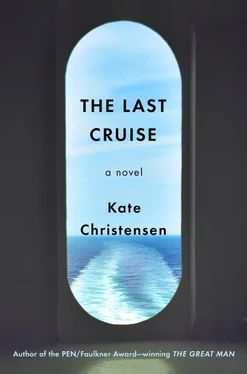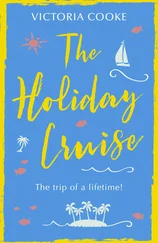She looked up from the brochure at the mild carpet of rippling water under the sky, two parallel planes through visible space of pure vanishing blue that appeared to meet at the soft gray horizon line that kept receding as the ship plowed on. Voices were amplified by the warm spray in the air, increasing in volume then fading out and replaced by others as people moved about the deck. To her relief, she heard no children’s shrieks or squeals or whines. The cutoff age, she had been told, was sixteen, but even teenagers seemed in short supply. There was one sullen-looking, slightly overweight college-aged girl in a blue sweatshirt sitting in a chair reading the same brochure, seemingly as engrossed as Christine in the Isabella ’s facts and background. She looked up and met Christine’s eye and immediately looked away. She struck Christine as the kind of girl who would keep to herself for the duration of the voyage, watching the drunken, carefree adults around her with satirical sharpness, recording her observations in a journal. Christine had been the same way at that age.
The third and fourth pages of the brochure were taken up by a history of the Queen Isabella, written by Tye and James Blevins, whoever they were. Christine braced herself for the usual groan-worthy cheeseball prose of restaurant menus or cheap museum placards, but she was pleasantly surprised and even amused by the cheekily ironic, fairy tale–like tone.
“Once upon a time,” the story began, “in 1953, a ship named the Queen Isabella was born. This was a heady era, the golden age of capitalism and nuclear energy and a generally held, naively wide-eyed belief in human progress. In those days, it was considered romantic to smoke and glamorous to drink Coca-Cola and patriotic to support the automotive industry by driving cars that looked like bloated fish.”
Christine glanced up at the teenage girl. She was absorbed in her own brochure.
“The Isabella started out her life as the oldest of identical triplets: the (now-defunct) Queen Eleanor and the (oft-renamed, soon-to-be-scrapped) Queen Melisende. The three sisters had been commissioned five years earlier, in 1948, by Anne-Marie de Belloc, the reclusive, childless, and (filthy) rich widow of a French industrialist, and were built by Forges et Chantiers de la Gironde at Lormont near Bordeaux on the Gironde estuary. Unfortunately, due to some bad investments and even worse luck, the widow went broke, and by 1953, the year of the Queen Isabella ’s completion, Mme de Belloc had sold her houses, her considerable stash of jewels, and other holdings to pay her debts. But, by dint of a sleight-of-hand false sale to her maid, she managed to keep her ships. The Isabella was put to work immediately, carrying paying passengers and plying the Mediterranean, to support not only Mme. de Belloc, but also her poor half-formed sisters, the Queens Melisende and Eleanor, stalled in a Marseille shipyard. They languished on the ways for the next two years and, when the former millionaire could no longer afford the rental of their berths, were almost abandoned forever and sold for scrap. Then, at the proverbial eleventh hour, de Belloc, forty-three but still seaworthy herself, managed to wed an elderly Greek shipping magnate, Stavros Chronis, whose fortunes allowed the two sister ships to be completed, outfitted with teak-decked balconies, beveled chrome vitrines, crystal chandeliers, and soaking tubs inlaid with mother-of-pearl.”
Christine envisioned Anne-Marie with a blond scalloped bouffant, dove-breasted, hard-faced, but with vulnerable brown eyes. She’d married the rich Greek to save her ships, a marriage that Christine pictured as polite, chilly, and entirely public except when Stavros demanded that his wife fulfill her sexual duties.
“Each ship’s accommodations ranged from the two super-luxurious multiroom double-balconied owner’s and presidential suites, bulging from the sides with views both fore and aft, all the way down to the inner windowless bunk-bed cells for the crew. During the early 1960s, the Chronis Corporation sailed the now extremely popular sisters under the Greek flag on a leisurely circuit around the Mediterranean: Gibraltar, Valencia, Lisbon, Naples, Cannes, Thessaloníki, Barcelona, Beirut, Athens, and Genoa.”
The names evoked in Christine a sunstruck, piney fantasia of olives, retsina, grilled sardines, and hot late nights in seaside cafés.
“Even though the three sisters were virtually identical, equally beautiful and luxurious, the Isabella was always the favorite. Maybe because of her status as the first to be launched and sailed, maybe because of the fortuitous historical connotations of her name, Americans in particular (some of whom were at least passingly familiar with Queen Eleanor of Aquitaine but not, generally, with Queen Melisende of Jerusalem) preferred her. The rich and famous of the era booked her suites and dined on filet mignon and oysters Rockefeller at the captain’s table, danced the cha-cha and the tango to hot bands in the ballroom, drank martinis and cognac in the Starlight Lounge, smoked cheroots in the casino. Natalie Wood posed for a spread in Life magazine aboard the Isabella. Buzz Aldrin and his wife enjoyed a luxurious week in one of her first-class suites, as did President Nixon. Joe DiMaggio and Marilyn Monroe were caught necking by paparazzi near the swimming pool. Gene Kelly made a splash in the ballroom for a dazzling night, squiring several starstruck matrons around the teak parquet floor, dipping one so low her diamond brooch fell off, then famously dipping her again at the end of the dance so he could pick it up again and hand it back to her.”
Christine laughed aloud: it was all so improbable. And here she was, Christine Thorne from western Maine, spending two weeks on a ship whereon presidents, movie stars, and astronauts had vacationed.
“Just like all great beauties, the Isabella grew older and frailer. After her sisters died natural deaths, she was getting ready for her own retirement when Cabaret Cruises swooped in, adding this sentimental favorite to its fleet in 2002 and restoring her, almost completely, to her former glory. For fifteen years, refreshed and fully renovated, she sailed the Pacific Ocean from Long Beach, her adopted home, up to Alaska and down to Mexico and out to the Hawaiian Islands. And now, at last, after a long and fruitful life of dignity, health, and success, the Queen Isabella is making her final voyage. Her last cruise will be a celebration of the glorious era of glamour and elegance, a theater of nostalgia.”
Christine closed the brochure and leaned back in her chair. She had been aware for a while of a thrumming deep in the bowels of the ship, like a constant presence, a noise she could feel in her bones, the sub-aural hum of the engines. Simultaneously, she noticed the gentle fore-and-aft rocking of the ship as the bow plowed steadily through each rolling impulse of water, muscling through one broad swell after another. She felt safe, unaffected by the scale of the effort, like a flea perched on the back of a smoothly cantering horse. The relationship between ship and water didn’t affect her. She was too small, of a whole other scale. Her body reacted only to sun and air while the ship did all the work of moving. It was so relaxing, she found her eyes closing slightly, her muscles giving up their terrestrial battle against gravity. Her mouth went slack, and she felt herself beginning to drool and closed it. No wonder people went on cruises.
“Shut up, ” someone shrieked nearby, a throaty male voice. “No way. ”
“The pool is tiny,” came a snotty female voice from the other direction. “I can’t believe how small. It smells musty in our room, too.”
Читать дальше












